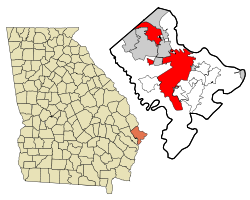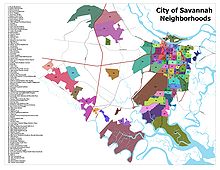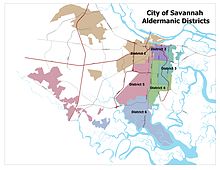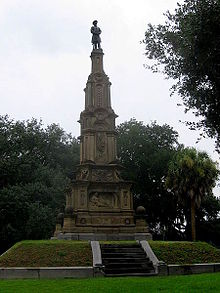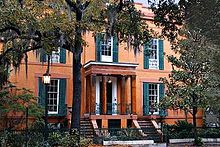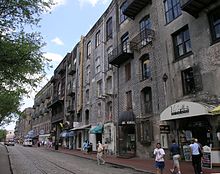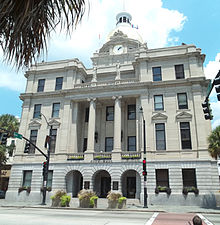- Savannah, Georgia
-
This article is about a city in the U.S. state of Georgia. For other uses of Savannah, see Savannah (disambiguation).
City of Savannah — City — 
SealNickname(s): "The Hostess City of the South" Location in Chatham County and the state of Georgia Coordinates: 32°04′52″N 81°05′28″W / 32.08111°N 81.09111°WCoordinates: 32°04′52″N 81°05′28″W / 32.08111°N 81.09111°W Country United States State Georgia County Chatham Government – Mayor Otis S. Johnson – City Manager Rochelle Small-Toney Area – City 108.7 sq mi (281.5 km2) – Land 103.1 sq mi (267.1 km2) – Water 5.6 sq mi (14.4 km2) Elevation 49 ft (15 m) Population (2010) – City 136,286 – Density 1,321.2/sq mi (510.1/km2) – Metro 347,611 Time zone EST (UTC−5) – Summer (DST) EDT (UTC−4) Area code(s) 912 FIPS code 13-69000[1] GNIS feature ID 0322590[2] Website SavannahGA.gov Savannah is the largest city and the county seat of Chatham County, in the U.S. state of Georgia. Established in 1733, the city of Savannah was the colonial capital of the Province of Georgia and later the first state capital of Georgia.[3] Today Savannah is an industrial center and an important Atlantic seaport. It is Georgia's fourth largest city and third largest metropolitan area.
Each year Savannah attracts millions of visitors, who enjoy the city's architecture and historic buildings: the birthplace of Juliette Gordon Low (founder of the Girl Scouts of the United States of America), the Telfair Academy of Arts and Sciences (one of the South's first public museums), the First African Baptist Church (one of the oldest African American Baptist congregations in the United States), Temple Mickve Israel (the third oldest synagogue in America), and the Central of Georgia Railway roundhouse complex (the oldest standing antebellum rail facility in America).[3][4]
Savannah's downtown area, which includes the Savannah Historic District, the Savannah Victorian Historic District and 22 parklike squares, is one of the largest National Historic Landmark Districts in the United States (designated by the U.S. government in 1966).[3][A] Savannah was the host city for the sailing competitions during the 1996 Summer Olympics held in Atlanta, Georgia.
Contents
History
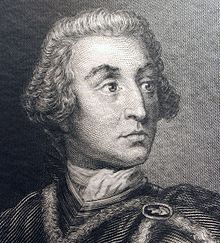 General James Edward Oglethorpe, a philanthropist and a representative of King George II to the American colonies, was sent to create a buffer south of the Savannah River to protect the Carolinas from Spanish Florida and French Louisiana.
General James Edward Oglethorpe, a philanthropist and a representative of King George II to the American colonies, was sent to create a buffer south of the Savannah River to protect the Carolinas from Spanish Florida and French Louisiana.
On February 12, 1733, General James Oglethorpe and his settlers landed at Yamacraw Bluff and were greeted by Tomochichi, the Yamacraws, and Indian traders John and Mary Musgrove. Mary Musgrove often served as a translator. The city of Savannah was founded on that date, along with the colony of Georgia. In 1751 Savannah and the rest of Georgia became a Royal Colony and Savannah was made the colonial capital of Georgia.[5]
The city was named for the Savannah River, which probably derives from variant names for the Shawnee, a Native American people who migrated to the river in the 1680s. The Shawnee destroyed another Native people, the Westo, and occupied their lands at the head of the Savannah River's navigation on the fall line, near present-day Augusta.[6] These Shawnee were known by several local variants, including Shawano, Savano, Savana and Savannah.[7] Another theory is that the name Savannah refers to the extensive marshlands surrounding the river for miles inland, and is derived from the English term savanna, a kind of tropical grassland, which was borrowed by the English from Spanish sabana and used in the Southern Colonies. (The Spanish word comes from the Taino word zabana.)[8] Still other theories suggest that the name Savannah originates from Algonquian terms meaning "southerner" or perhaps "salt".[9][10]
Geography
According to the United States Census Bureau, Savannah has a total area of 78.1 square miles (202.3 km2), of which 74.7 square miles (193.5 km2) is land and 3.4 square miles (8.8 km2) is water (4.31%). Savannah is the primary port on the Savannah River and the largest port in the state of Georgia. It is also located near the U.S. Intracoastal Waterway. Georgia's Ogeechee River flows toward the Atlantic Ocean some 16 miles (26 km) south of the city.
Savannah is prone to flooding. Five canals and several pumping stations have been built to help reduce the effects: Fell Street Canal, Pipemaker's Canal, Kayton Canal, Springfield Canal and the Casey Canal, with the first four draining north into the Savannah River.
Climate
Savannah's climate is classified as humid subtropical (Köppen Cfa). In the Deep South this climate is characterized by long and almost tropical summers, with temperatures reaching freezing only a few times in the winter (and with rare snowfall). Due to its proximity to the Atlantic coast, Savannah rarely experiences temperatures as extreme as those in Georgia's interior. Nevertheless, temperatures as high as 105 °F (41 °C) and as low as 3 °F (−16 °C) have been recorded.[11] Summers tend to be humid with many thunderstorms. Nearly half of Savannah's precipitation falls during the months of June through September, characteristic of monsoon-type climates. As the city is south of the snow line, it rarely receives snow in winter. Occasional Arctic cold fronts in winter can push nighttime temperatures into the high 20s, but rarely much further than that.[12]
Savannah is at risk for hurricanes, particularly of the Cape Verde type. Because of its location in the Georgia Bight (the arc of the Atlantic coastline in Georgia and northern Florida) as well as the tendency for hurricanes to re-curve up the coast, Savannah has a lower risk of hurricanes than some other coastal cities such as Charleston, South Carolina. Savannah was seldom affected by hurricanes during the 20th century, with one exception being Hurricane David in 1979. However, the historical record shows that the city was frequently affected during the second half of the 19th century. The most prominent of these storms was the 1893 Sea Islands hurricane, which killed at least 2,000 people. (This estimate may be low, as deaths among the many impoverished rural African-Americans living on Georgia's barrier islands may not have been reported.)
Climate data for Savannah, Georgia Month Jan Feb Mar Apr May Jun Jul Aug Sep Oct Nov Dec Year Average high °F (°C) 60.4
(15.8)64.1
(17.8)71.0
(21.7)77.7
(25.4)84.3
(29.1)89.5
(31.9)92.3
(33.5)90.3
(32.4)86
(30)78.1
(25.6)70.5
(21.4)62.6
(17.0)77.23
(25.13)Average low °F (°C) 38.0
(3.3)40.9
(4.9)47.5
(8.6)52.9
(11.6)61.3
(16.3)68.1
(20.1)71.8
(22.1)71.3
(21.8)67.3
(19.6)56.1
(13.4)46.9
(8.3)40.1
(4.5)55.18
(12.88)Precipitation inches (mm) 3.95
(100.3)2.92
(74.2)3.64
(92.5)3.32
(84.3)3.61
(91.7)5.49
(139.4)6.04
(153.4)7.20
(182.9)5.08
(129)3.12
(79.2)2.40
(61)2.81
(71.4)49.58
(1,259.3)Avg. precipitation days (≥ 0.01 in) 10.0 8.0 8.6 6.6 8.3 11.2 12.7 13.2 10.5 6.3 6.8 8.6 110.8 Sunshine hours 176.7 183.6 232.5 276.0 288.3 276.0 272.8 244.9 213.0 229.4 192.0 173.6 2,758.8 Source: NOAA,[13] HKO (sun) [14] The first meteorological observations in Savannah probably occurred at Oglethorpe Barracks circa 1827. Observations at the barracks continued intermittently until 1850 and resumed in 1866. The Signal Service began observations in the early 1870s. Today, the National Weather Service records local weather observations at Savannah-Hilton Head International Airport.
Urban
Neighborhoods
Savannah is a city of diverse neighborhoods. More than 100 distinct neighborhoods can be identified in six principal areas of the city: Downtown (Landmark Historic District and Victorian District), Midtown, Southside, Eastside, Westside, and Southwest/West Chatham (recently annexed suburban neighborhoods).
Demographics
Historical populations Census Pop. %± 1800 5,146 — 1810 5,215 1.3% 1820 7,523 44.3% 1830 7,303 −2.9% 1840 11,214 53.6% 1850 15,312 36.5% 1860 22,292 45.6% 1870 28,235 26.7% 1880 30,709 8.8% 1890 43,189 40.6% 1900 54,244 25.6% 1910 65,064 19.9% 1920 83,252 28.0% 1930 85,024 2.1% 1940 95,996 12.9% 1950 119,638 24.6% 1960 147,537 23.3% 1970 118,349 −19.8% 1980 141,654 19.7% 1990 137,560 −2.9% 2000 131,510 −4.4% 2010 136,286 3.6% According to the 2010 U.S. Census, Savannah had a population of 136,286, slightly up from the official 2000 count of 131,510 residents.[15] Between 2000 and 2010, the population of the Savannah Metropolitan Statistical Area (defined by the U.S. Census Bureau as Bryan, Chatham, and Effingham counties) grew from 293,000 to 347,611, an increase of 18.6 percent.[16] Savannah is also the largest principal city of the Savannah-Hinesville-Fort Stewart CSA, a larger Combined Statistical Area that includes the Savannah and Hinesville-Fort Stewart metropolitan areas, which had a combined estimated population of 417,512 in 2009 (up from 364,914 at the 2000 census).[1][17][18]
In the 2000 census[1] of Savannah, there were 131,510 people, 51,375 households, and 31,390 families residing in the city.[19] The population density was 1,759.5 people per square mile (679.4/km²). There were 57,437 housing units at an average density of 768.5 per square mile (296.7/km²). The racial makeup of the city was 57.08% Black, 36.09% White, 4.52% Asian, 2.23% Native American, 0.07% Pacific Islander, 0.93% from other races, and 1.30% from two or more races. Hispanic or Latino of any race were 8.23% of the population.
There were 51,375 households out of which 28.5% had children under the age of 18 living with them, 35.2% were married couples living together, 21.7% had a female householder with no husband present, and 38.9% were non-families. 31.4% of all households were made up of individuals and 11.5% had someone living alone who was 65 years of age or older. The average household size was 2.45 and the average family size was 3.13.
In the city the population was spread out with 25.6% under the age of 18, 13.2% from 18 to 24, 28.5% from 25 to 44, 19.5% from 45 to 64, and 13.3% who were 65 years of age or older. The median age was 32 years. For every 100 females there were 89.3 males. For every 100 females age 18 and over, there were 84.6 males.
The median income for a household in the city was $29,038, and the median income for a family was $36,410. Males had a median income of $28,545 versus $22,309 for females. The per capita income for the city was $16,921. About 17.7% of families and 21.8% of the population were below the poverty line, including 31.4% of those under age 18 and 15.1% of those age 65 or over.
Government
Savannah's government became a council/manager form of government in 1954. The city council consists of the mayor and eight aldermen, six of which are elected from one of six aldermanic districts, with each district electing one member. The other two members and the mayor are elected at-large.
The council levies taxes, enacts ordinances, adopts the annual budget, and appoints the City Manager.[20] The City Manager enacts the policies and programs established by council, recommends an annual budget and work programs, appoints bureau and department heads, and exercises general supervision and control over all employees of the city.[20]
Consolidation with Chatham County
In 2003 Savannah and Chatham County voted to merge their city and county police departments. The Savannah-Chatham Metro Police was established on January 1, 2005, after the Savannah Police Department and Chatham County Police Department merged. The department has a number of specialty units, including: K-9, SWAT, Bomb Squad, Marine Patrol, Dive, Air Support and Mounted Patrol. The 9-1-1 Communications Dispatch Center handles all 9-1-1 calls for service within the County and City, including fire and EMS.
While some see the police merger as a step toward city-county consolidation, Savannah is actually one of eight incorporated cities or towns in Chatham County. (The others are Bloomingdale, Garden City, Pooler, Port Wentworth, Thunderbolt, Tybee Island and Vernonburg). Although these seven smaller localities would remain independent from a consolidated government, they have long opposed any efforts to adopt a city-county merger. One fear is that consolidation would reduce county funding to areas outside of Savannah. Efforts toward city-county consolidation are also opposed by some wealthier Chatham County communities, including The Landings on Skidaway Island, since these residents fear higher tax rates in a consolidated government. However, consolidation is favored by some city and county boosters, including Savannah's main newspaper, and merger plans have been presented to state legislators in the recent past. Should consolidation pass, Savannah would become Georgia's second largest city (behind Atlanta's 420,000 residents), with a population of around 223,000. By state law, the roughly 42,000 residents of the seven smaller incorporated towns would remain independent; they are not included in a Savannah-Chatham consolidation plan. Without special provisions, however, some of these towns would find themselves permanently locked into their current city limits without possibility of further annexation.
State representation
The Georgia Department of Corrections operates the Coastal State Prison in Savannah.[21][22]
Economy
 A container ship leaves the Port of Savannah after passing under the Talmadge Memorial Bridge and proceeding down the Savannah River past the Savannah Historic District.
A container ship leaves the Port of Savannah after passing under the Talmadge Memorial Bridge and proceeding down the Savannah River past the Savannah Historic District.
Agriculture was essential to Savannah's economy during its first two centuries. Silk and indigo production, both in demand in England, were early export commodities; by 1767 almost a ton of silk per year was exported to England.[23]
Georgia's mild climate offered perfect conditions for growing cotton, which became the dominant commodity after the American Revolution. Its production under the plantation system and shipment through the Port of Savannah helped the city's European immigrants to achieve wealth and prosperity.
In the nineteenth century, the Port of Savannah became one of the most active in the United States, and Savannahians had the opportunity to consume some of the world's finest goods, imported by foreign merchants. Savannah's port has always been a mainstay of the city's economy. In the early years of the United States, goods produced in the New World had to pass through Atlantic ports such as Savannah's before they could be shipped to England.
Today, the Port of Savannah, manufacturing, the military and the tourism industry are Savannah's four major economic drivers. In 2006, the Savannah Area Convention & Visitors Bureau reported over 6.85 million visitors to the city during the year. Lodging, dining, entertainment, and visitor-related transportation account for over $2 billion in visitors' spending per year and employ over 17,000.
For years, Savannah was the home of Union Camp, which housed the world's largest paper mill. The plant is now owned by International Paper, and it remains one of Savannah's largest employers. Savannah is also home to the Gulfstream Aerospace company, maker of private jets, as well as various other large industrial interests. Morris Multimedia, a newspaper and television company, is based in Savannah.
In 2000, JCB, the third largest producer of construction equipment in the world and the leading manufacturer of backhoes and telescopic handlers, built its North American headquarters in Chatham County near Savannah in Pooler on I-95 near Savannah-Hilton Head International Airport.
In 2009, Savannah was North America's fourth largest port by container traffic.[24]
Arts and Culture
Beyond its architectural significance as being the nation's largest, historically restored urban area, the City of Savannah has a rich and growing performing arts scene, offering cultural events throughout the year.
Dance
Savannah Dance Theatre — Established in 1998 as a nonprofit organization, the theatre has grown to become the city’s largest dance company.[25]
Music
- The Coastal Jazz Association — Presents a variety of jazz performances throughout the year in addition to hosting the annual Savannah Jazz Festival.[26]
- Savannah Children's Choir — Non-profit, auditioned choir for children in 2nd through 8th grades that performs throughout the community and in annual holiday and spring concerts.[27]
- Savannah Concert Association — Presents a variety of guest artists for chamber music performances each season. Performances are generally held in the Lucas Theatre For The Arts.[28]
- Savannah Music Festival — An annual music festival of diverse artists.
- The Savannah Orchestra — Savannah's professional orchestra, which presents an annual season of classical and popular concert performances.[29]
- The Savannah Philharmonic — Professional orchestral and choral organization presenting year round concerts (classical, pops, education).[30]
- The Savannah Winds — Amateur concert band hosted by the music department of Armstrong Atlantic State University.[31]
Rock music
Several heavy metal music groups have emerged from Savannah.[32] Included in these are Baroness, Kylesa, and Circle Takes the Square.[32]
Theater and Performance
- Muse Arts Warehouse — Founded in 2010, Muse Arts Warehouse is a nonprofit organization committed to community-building through the arts by providing a venue that is available, affordable, and accessible to Savannah's individual artists, arts organizations and the public.[33]
- Savannah Children's Theatre — A non-profit, year-round drama theatre company geared toward offering elementary through high school students (and adults) opportunities for participation in dramatic and musical productions.[34]
- Savannah Community Theatre — A full theater season with a diverse programming schedule, featuring some of Savannah's finest actors in an intimate, three-quarter-round space.[35]
- Little Theatre of Savannah— Founded in 1950, The Little Theatre of Savannah, Inc., is a nonprofit, volunteer-based community organization dedicated to the celebration of the theater arts. Recognizing the unique social value, expressive fulfillment and opportunity for personal growth that theater provides its participants, the Little Theatre of Savannah invites all members of the community to participate both on- and off-stage.[36]
- Savannah Theatre — Savannah's only fully professional resident theater, producing music revues with live singers, dancers and the most rockin' band in town. Performances happen year-round, with several different titles and a holiday show.[37]
Points of interest
Savannah's architecture and history are internationally known, as is its reputation for Southern charm and hospitality; for example, the city's former promotional name was "Hostess City of the South," a phrase still used by the city government.[38][39] . An earlier nickname was "the Forest City", in reference to the large population and species of oak trees that flourish in the Savannah area. These trees were especially valuable in shipbuilding during the 19th century[40]. Each year, Savannah attracts millions of visitors from across the country and around the world.[41] Savannah's downtown area is one of the largest National Historic Landmark Districts in the United States.[5]
The city's location offers visitors access to the coastal islands and the Savannah Riverfront, both popular tourist destinations. Tybee Island, formerly known as "Savannah Beach", is the site of the Tybee Island Light Station, the first lighthouse on the southern Atlantic coast. Other picturesque towns adjacent to Savannah include the shrimping village of Thunderbolt and three residential areas that began as summer resort communities for Savannahians: Beaulieu, Vernonburg and the Isle of Hope.
The Savannah International Trade & Convention Center is located on Hutchinson Island, across from downtown Savannah and surrounded by the Savannah River. The Belles Ferry connects the island with the mainland, as does the Eugene Talmadge Memorial Bridge.
The Savannah Civic Center is located on Montgomery Street and is host to over 900 events each year, including the Memorial Health Hockey Classic.
Squares
Savannah's historic district has 22 squares (Ellis Square, demolished in 1954, was fully restored in early 2010).[42][43] The squares vary in size and personality, from the formal fountain and monuments of the largest, Johnson, to the playgrounds of the smallest, Crawford. Elbert, Ellis, and Liberty Squares are classified as the three "lost squares," destroyed in the course of urban development during the 1950s. Elbert and Liberty Squares were paved over to make way for a realignment of U.S. highway 17, while Ellis Square was demolished to build the City Market parking garage. The city restored Ellis Square after razing the City Market parking garage. The garage has been rebuilt as an underground facility, the Whitaker Street Parking Garage, and it opened in January 2009. The newly restored Ellis Square opened in March 2010.[44] Separate efforts are now under way to revive Elbert and Liberty Squares.
Historic churches and synagogues
Savannah is home to a number of historic houses of worship.
Founded in 1733, with the establishment of the Georgia colony, Christ Church is the longest continuous Christian congregation in Georgia.[citation needed] Early rectors include the Methodist evangelists John Wesley and George Whitefield. Located on the original site on Johnson Square, Christ Church continues as an active congregation.
The First Bryan Baptist Church is an African-American church that was organized by Andrew Bryan in 1788. The site was purchased in 1793 by Bryan, a former slave who had also purchased his freedom. The first structure was erected there in 1794. By 1800 the congregation was large enough to split: those at Bryan Street took the name of First African Baptist Church, and Second and Third African Baptist churches were also established.[45] The current sanctuary of First Bryan Baptist Church was constructed in 1873.
In 1832, a controversy over doctrine caused the First African Baptist congregation at Bryan Street to split. Some members left, taking with them the name of First African Baptist Church. In 1859, the members of this new congregation (most of whom were slaves) built their current church building on Franklin Square.[45]
The oldest standing house of worship is First Baptist Church, Savannah (1833), located on Chippewa Square. Also located near Chippewa Square is the Independent Presbyterian Church, which was founded in 1775.
Other historic houses of worship in Savannah include: Cathedral of St. John the Baptist (Roman Catholic), Temple Mickve Israel (the third oldest synagogue in the U.S.),[3] and St. John's Church (Episcopal).
Historic homes
Among the historic homes that have been preserved are: the Pink House, the Sorrel Weed House, Juliette Gordon Low's birthplace, the Green-Meldrim House, the Owens-Thomas House, the William Scarbrough House, and the Wormsloe plantation of Noble Jones. The Mercer-Williams House, the former home of Jim Williams, is the main location of Midnight in the Garden of Good and Evil
Historic cemeteries
Colonial Park Cemetery (an early graveyard dating back to the English colony of Georgia), Laurel Grove Cemetery (with the graves of many Confederate soldiers and African American slaves) and Bonaventure Cemetery (a former plantation and the final resting place for some illustrious Savannahians).
Historic forts
- Fort Jackson — near the historic district
- Fort Pulaski National Monument — 17 miles (27 km) east of Savannah via the Islands Expressway
Other registered historic sites
- Savannah Historic District and the Savannah Victorian Historic District
- Forsyth Park
- Juliette Gordon Low Historic District
- Central of Georgia Railroad: Savannah Shops and Terminal Facilities and Central of Georgia Depot and Trainshed — a 33.2-acre (134,000 m2) historic district that was listed on the National Register of Historic Places in 1978.[46][47]
- Riverfront Plaza and Factors' Walk — River Street's restored nineteenth-century cotton warehouses and passageways include shops, bars and restaurants
- City Market — Savannah's restored central market features antiques, souvenirs, small eateries, as well as two large outdoor plazas
- Savannah State University campus and Walter Bernard Hill Hall — The Georgia Historical Commission and the Georgia Department of Natural Resources have recognized both the Savannah State campus and Hill Hall as a part of the Georgia Historical Marker Program.[48] Hill Hall, which was built in 1901, was added to the National Register of Historic Places in 1981.[49]
- Telfair Museum of Art and Telfair Academy of Arts of Sciences — the South’s first public art museum.
- Ossabaw Island
Shopping
Other attractions
- Bamboo Farm and Coastal Gardens
- Pinkie Masters Bar which has been the site of presidential visits and political aspiration. Pinkie Masters (a local political figure) was a friend of President Jimmy Carter, who made several visits to the bar and the city.
- Club One — Home of The Lady Chablis made famous in the book and movie Midnight in the Garden of Good and Evil.[50]
- Saint Patrick's Day Celebrations — Annually Savannah holds celebrations in honor of Saint Patrick's Day. The actual parade route changes from year to year but usually travels through Savannah's Historic Park District and along Bay Street. The Savannah Waterfront Association has an annual celebration on Historic River Street that is reminiscent of Mardi Gras on Bourbon Street in New Orleans.
- Oatland Island Education Center — facility owned and operated by the Board of Education, is a place to see animals that are or were found in this region.
- Tybee Island — popular coastal city with public beaches and attractions.
- Pirates' House - historic restaurant and tavern located in downtown Savannah.
Sports and recreation
Professional sport teams
Club Sport League Venue Championships Notes Savannah Braves Baseball Southern League Grayson Stadium 0 1971–1983 Savannah Cardinals Baseball South Atlantic League Grayson Stadium 2 (1993, 1994) 1984–1995 Savannah Sand Gnats Baseball South Atlantic League Grayson Stadium 1 (1996) 1996 — present Savannah Spirits Basketball Continental Basketball Association Savannah Civic Center 0 1986–1988 Savannah Wildcats Basketball Continental Basketball League Armstrong Atlantic State University 1 (2010) 2010 — present Savannah Storm Basketball American Basketball Association 2010 — present College teams
Club Affiliation Conference Venues Notes Armstrong Atlantic State Pirates NCAA Division II Peach Belt Conference Alumni Arena Savannah College of Art and Design Bees NAIA Florida Sun Conference Ron Love Athletic Center Savannah State Tigers NCAA Division I (FCS) MEAC Tiger Arena, Ted Wright Stadium Sports facilities
Auto Racing
Baseball
Basketball
Hockey
Football
Education
 Historic Hill Hall on the campus of Savannah State University is one of several buildings in Savannah on the National Register of Historic Places
Historic Hill Hall on the campus of Savannah State University is one of several buildings in Savannah on the National Register of Historic Places
Savannah has four colleges and universities offering bachelor's, master's, and professional or doctorate degree programs: Armstrong Atlantic State University, Savannah College of Art and Design (SCAD), Savannah State University, and South University. In addition, Georgia Tech Savannah offers engineering degrees, and Georgia Southern University has a satellite campus in the downtown area. Savannah Technical College, a two-year technical institution, and the Skidaway Institute of Oceanography, a marine science research institute located on the northern end of Skidaway Island, offer educational programs as well. Savannah is also the location of Ralston College, a liberal arts college founded in 2010. [51]
Mercer University began a four-year doctor of medicine program in August 2008 at Memorial University Medical Center. Mercer, with its main campus in Macon, received additional state funding in 2007 to expand its existing partnership with Memorial by establishing a four-year medical school in Savannah (the first in southern Georgia). Third- and fourth-year Mercer students have completed two-year clinical rotations at Memorial since 1996; approximately 100 residents are trained each year in a number of specialities. The expanded program opened in August 2008 with 30 first-year students.
Savannah is also home to most of the public schools in the Chatham County public school system, the Savannah-Chatham County Public Schools.
Other notable schools include:
- Beach High School
- Benedictine Military School
- Calvary Day School
- Islands High School
- Jenkins High School
- Johnson High School
- Savannah Christian Preparatory School
- Savannah Arts Academy
- Savannah Country Day School
- Savannah High School
- Saint Andrew's School
- St. Vincent's Academy
- Windsor Forest High School
Oatland Island Wildlife Center of Savannah is also a part of Savannah-Chatham County Public Schools. Formerly named the Oatland Island Education Center until a name change in 2007, the environmental education center serves thousands of students from school systems throughout the Southeastern United States. It is located just east of Savannah on a marsh island and features a 2-mile (3.2 km) Native Animal Nature Trail that winds through maritime forest, salt marsh, and freshwater wetlands. Along the trail, visitors can observe native animals, such as Florida panthers, Eastern timber wolves, and alligators, in their natural habitat.
Media
Savannah's major television stations are WSAV, channel 3 (NBC); WTOC-TV, channel 11 (CBS); WJCL, channel 22 (ABC); and WTGS, channel 28 (Fox). Two PBS member stations serve the city: WVAN (channel 9), part of Georgia Public Broadcasting; and WJWJ-TV (channel 16), part of SCETV.
Other stations include WGSA-TV, channel 34 (The CW); and WXSX-CA, channel 46 (MTV2).
The Savannah Morning News is Savannah's only daily newspaper. The Savannah Tribune is a weekly newspaper with a focus on Savannah's African American community. Connect Savannah is an alternative free weekly newspaper focused on local news, culture and music.[52][53]
Infrastructure
Transportation
Savannah/Hilton Head International Airport is located off Interstate 95 west of Savannah. Airlines serving this airport are Delta, Delta Connection, Continental Express, United Express, US Airways, Vision Airlines and American Eagle. Until September 2008, DayJet provided on-demand air transportation service between Savannah and cities throughout the Southeast.
Amtrak operates a passenger terminal at Savannah for the Palmetto and Silver Service trains running between New York City and Miami, Florida with three southbound and three northbound trains stopping at the station daily.
Public transit throughout the region is provided by Chatham Area Transit.
The DOT (Downtown Transportation) system provides fare free transportation in the Historic District.[54] Services include an express shuttle buses, the River Street Streetcar, and a ferry to Hutchinson Island and the Savannah International Trade and Convention Center.[54]
Interstates and major highways
 Interstate 95 — Runs north-south just west of the city; provides access to Savannah/Hilton Head International Airport, and intersects with Interstate 16 which leads into the city's center.
Interstate 95 — Runs north-south just west of the city; provides access to Savannah/Hilton Head International Airport, and intersects with Interstate 16 which leads into the city's center. Interstate 16 — Terminates in downtown Savannah at Liberty and Montgomery Streets, and intersects with Interstate 95 and Interstate 516.
Interstate 16 — Terminates in downtown Savannah at Liberty and Montgomery Streets, and intersects with Interstate 95 and Interstate 516. Interstate 516 — An urban perimeter highway connecting Southside Savannah, at DeRenne Avenue, with the industrialized port area of the city to the north; intersects with the Veterans Parkway and Interstate 16, as well. Also known as Lynes Parkway.
Interstate 516 — An urban perimeter highway connecting Southside Savannah, at DeRenne Avenue, with the industrialized port area of the city to the north; intersects with the Veterans Parkway and Interstate 16, as well. Also known as Lynes Parkway. U.S. Route 80 (Victory Drive) — Runs east-west through Midtown Savannah and connects the city with the town of Thunderbolt, and the islands of Whitemarsh, Talahi, Wilmington and Tybee. Merges with the Islands Expressway and serves as the only means of reaching the beach by automobile.
U.S. Route 80 (Victory Drive) — Runs east-west through Midtown Savannah and connects the city with the town of Thunderbolt, and the islands of Whitemarsh, Talahi, Wilmington and Tybee. Merges with the Islands Expressway and serves as the only means of reaching the beach by automobile. State Route 204 (Abercorn Expressway) — An extension of Abercorn Street that begins at 37th Street (which is its northern point) and terminates at Rio Road and the Forest River at its southern point, and serves as the primary traffic and commercial artery linking downtown, midtown and southside sections of the city.
State Route 204 (Abercorn Expressway) — An extension of Abercorn Street that begins at 37th Street (which is its northern point) and terminates at Rio Road and the Forest River at its southern point, and serves as the primary traffic and commercial artery linking downtown, midtown and southside sections of the city.- Harry S. Truman Parkway — Runs through the eastside of town, connecting the east end of Downtown with Southside Savannah. The road has been under construction since 1992, and is opening in phases with the latest phase opening in 2004.
- Veterans Parkway — Links Interstate 516 and Southside/Midtown Savannah with South Savannah, and is intended to move traffic quicker from north-south by avoiding high-volume Abercorn Expressway. Also known as the Southwest Bypass.
- Islands Expressway — An extension of President Street to facilitate traffic moving between Downtown Savannah and the barrier islands, as well as the beaches of Tybee Island
Crime
The total number of violent crimes in the Savannah-Chatham County reporting area ran just above 1,000 per year from 2003 through 2006. In 2007, however, the total number of violent crimes jumped to 1,163. Savannah-Chatham has recorded between 20 and 25 homicides each year since 2005.
In 2007, Savannah-Chatham recorded a sharp increase in home burglaries but a sharp decrease in larcenies from parked automobiles. During the same year, statistics show a 29 percent increase in arrests for Part 1 crimes. [55]
An additional increase in burglaries occurred in 2008 with 2,429 residential burglaries reported to Savannah-Chatham police that year. That reflects an increase of 668 incidents from 2007. In 2007, there were 1,761 burglaries, according to metro police data. [56]
Savannah-Chatham police report that crimes reported in 2009 came in down 6 percent from 2008.
In 2009, 11,782 crimes were reported to metro police — 753 fewer than in 2008. Within that 2009 number is a 12.2 percent decrease in violent crimes when compared with 2008. Property crimes saw a 5.3 percent decline, which included a 5.2 percent reduction in residential burglary. In 2008, residential burglary was up by almost 40 percent.While some violent crimes increased in 2009, crimes like street robbery went down significantly.In 2009, 30 homicides were reported, four more than the year before. Also, 46 rapes were reported, nine more than the year before. In the meantime, street robbery decreased by 23 percent. In 2008, metro police achieved a 90 percent clearance rate for homicide cases, which was described as exceptional by violent crimes unit supervisors. In 2009, the department had a clearance rate of 53 percent, which police attributed to outstanding warrants and grand jury presentations.[57]
The SCMPD provide the public with up to date crime report information through an online mapping service. This information can be found at [1]
Sister cities
Savannah has three sister cities, as designated by Sister Cities International: [58]

Batumi (Ajaria, Georgia) 
Patras (Akhaia, Greece) 
Kaya (Burkina Faso) See also
- List of mayors of Savannah, Georgia
- List of people from Savannah, Georgia
- Savannah, Georgia in popular culture
- List of tallest buildings in Savannah
Notes
- A.^ Savannah had 24 original squares. Today 21 are still in existence. See Squares of Savannah, Georgia for additional information.
References
- ^ a b c "American FactFinder". United States Census Bureau. http://factfinder.census.gov. Retrieved 2008-01-31.
- ^ "US Board on Geographic Names". United States Geological Survey. 2007-10-25. http://geonames.usgs.gov. Retrieved 2008-01-31.
- ^ a b c d "Savannah". New Georgia Encyclopedia. Georgia Humanities Council and the University of Georgia Press. 2006-09-11. http://www.georgiaencyclopedia.org/nge/Article.jsp?id=h-1056&hl=y. Retrieved 2008-01-01.
- ^ "Savannah Information". Savannah Area Convention & Visitors Bureau. http://www.savannah-visit.com/info.asp. Retrieved 2008-01-01.
- ^ a b Savannah from the New Georgia Encyclopedia Online
- ^ Cashin, Edward J. (1986). Colonial Augusta: "Key of the Indian Countrey". Mercer University Press. p. 4. ISBN 9780865542174. http://books.google.com/books?id=tWSQXKCfGbwC&pg=PA4.
- ^ "Savannah River Basin". Georgia River Network. http://www.uga.edu/coastalnemo/Documents/GRN/savannah.pdf.
- ^ Bright, William (2004). Native American Placenames of the United States. University of Oklahoma Press. p. 424. ISBN 9780806135984. http://books.google.com/books?id=5XfxzCm1qa4C&pg=PA424.
- ^ Names in South Carolina, Volume 22, Institute for Southern Studies.
- ^ Names in South Carolina, Volume 16, Institute for Southern Studies.
- ^ "Average Weather for Savannah, GA – Temperature and Precipitation". The Weather Channel. http://www.weather.com/weather/wxclimatology/monthly/graph/USGA0506?from=36hr_bottomnav_undeclared. Retrieved December 6, 2009.
- ^ "USDA Plant Hardiness Zone Map". http://www.usna.usda.gov/Hardzone/hzm-se1.html.
- ^ "Climatography of the United States No. 20 (1971–2000)" (PDF). National Oceanic and Atmospheric Administration. July 2011. http://cdo.ncdc.noaa.gov/climatenormals/clim20/ga/097847.pdf. Retrieved 2010-05-19.
- ^ "Climatological Normals of Savannah". Hong Kong Observatory. http://www.weather.gov.hk/wxinfo/climat/world/eng/n_america/us/Savannah_e.htm. Retrieved 2010-05-19.
- ^ "American Fact Finder". http://factfinder2.census.gov/faces/nav/jsf/pages/searchresults.xhtml?refresh=#none.
- ^ "Metropolitan Area Population & Housing Patterns: 2000-2010". http://proximityone.com/metros0010.htm.
- ^ "METROPOLITAN STATISTICAL AREAS AND COMPONENTS". Office of Management and Budget. 2010-03-25. http://www.census.gov/popest/metro/files/2009/CBSA-EST2009-07.csv.
- ^ "COMBINED STATISTICAL AREAS AND COMPONENT CORE BASED STATISTICAL AREAS". Office of Management and Budget. 2007-05-11. http://www.census.gov/population/www/estimates/metro_general/2006/List6.txt. Retrieved 2009-03-20.[dead link]
- ^ "State & County QuickFacts: Savannah (city), Georgia". http://quickfacts.census.gov/qfd/states/13/1369000.html.
- ^ a b "City Government". City of Savannah. http://www.savannahga.gov/cityweb/SavannahGaGOV.nsf/mainportal/government?opendocument. Retrieved 2010-05-24.
- ^ "City of Savannah Neighborhoods 2008". City of Savannah. http://www.savannahga.gov/cityweb/CommServ.nsf/0/3fd39cb384a6334085256de20057df61/$FILE/neighborhoods08.pdf. Retrieved 2010-09-15.
- ^ "Coastal State Prison". Georgia Department of Corrections. http://www.dcor.state.ga.us/GDC/FacilityMap/html/coastal_state_prison.html. Retrieved 2010-09-15.
- ^ "Agriculture in Georgia: Overview". The New Georgia Encyclopedia. http://www.georgiaencyclopedia.org/nge/Article.jsp?path=/LandResources/Agriculture&id=h-2056. Retrieved 2007-11-16.
- ^ "North American Container Traffic". CMS Plus. http://aapa.files.cms-plus.com/Statistics/NORTHAMERICANPORTCONTAINERTRAFFIC2009.pdf. Retrieved 2011-08-24.
- ^ "Savannah Danse Theatre". http://www.savannahdansetheatre.org/.
- ^ "The Coastal Jazz Association". http://coastal-jazz.org.
- ^ "Savannah Children's Choir". http://savannahchoir.org.
- ^ "Savannah Concert Association". http://savannahconcertassociation.com.
- ^ "The Savannah Orchestra". http://savannahorchestra.org.
- ^ "The Savannah Philharmonic". http://thesavphilharmonic.org.
- ^ "The Savannah Winds". http://www.finearts.armstrong.edu/savindex.html.
- ^ a b Peisner, David (2009-11-09). "Metal in the Garden of Good and Evil". Spin. http://www.spin.com/articles/metal-garden-good-and-evil. Retrieved 2009-12-02.
- ^ "Muse Arts Warehouse". http://www.musesavannah.org.
- ^ "Savannah Children's Theatre". http://savannahchildrenstheatre.org.
- ^ "Savannah Community Theatre". http://savannahcommunitytheatre.com.
- ^ "Little Theatre of Savannah". http://littletheatreofsavannah.org.
- ^ "Savannah Theatre". http://savannahtheatre.com.
- ^ "City of Savannah Home Page". http://www.savannahga.gov/cityweb/SavannahGaGOV.nsf.
- ^ "About Savannah". City of Savannah. http://www.savannahga.gov/cityweb/webdatabase.nsf/pio_aboutsav?openview.
- ^ [www.n-georgia.com/savannah-the-forest-city.html "Savannah, the Forest City"]. www.n-georgia.com/savannah-the-forest-city.html.
- ^ "Savannah Convention and Visitors Bureau". http://www.savcvb.com/savannah/.
- ^ "Tour Savannah's Squares". http://www.officialsavannahguide.com/article_8.shtml. Retrieved 2007-11-16.
- ^ "Squares of Savannah". http://www.pps.org/great_public_spaces/one?public_place_id=609. Retrieved 2009-07-15.
- ^ "City celebrates Whitaker Street garage; next phase at Ellis Square". SavannahNow.com. Savannah Morning News and Evening Press. 2009-01-23. http://savannahnow.com/node/658965. Retrieved 2009-07-21.[dead link]
- ^ a b "First African Baptist Church of Savannah". PBS. http://www.pbs.org/wgbh/aia/part2/2p30.html. Retrieved 2009-01-29.
- ^ "National Register Information System". National Register of Historic Places. National Park Service. 2007-01-23. http://nrhp.focus.nps.gov/natreg/docs/All_Data.html.
- ^ Eric N. DeLony (February 15, 1978). "National Register of Historic Places Inventory-Nomination: Central of Georgia Railroad: Savannah Shops & Terminal Facilities" (PDF). National Park Service. http://pdfhost.focus.nps.gov/docs/NHLS/Text/78000970.pdf. Retrieved 2009-06-21. (includes 7 pages of drawings) and Accompanying 13 photos, from 1976, 1973, and 1962 (of which 3 show the Depot that is part of the NHL)PDF (21.6 KB)
- ^ "Georgia Historical Markers". University of Georgia Carl Vinson Institute of Government. 2006. Archived from the original on 2007-04-10. http://web.archive.org/web/20070410113226/http://www.cviog.uga.edu/Projects/gainfo/gahistmarkers/gamarkersA-E.htm#anchor813579. Retrieved 2007-05-04.
- ^ "National Register of Historic Places". http://www.nationalregisterofhistoricplaces.com/ga/Chatham/state.html. Retrieved 2007-05-04.
- ^ "Club One". http://www.clubone-online.com.
- ^ "Ralston College". http://www.ralston.ac.
- ^ "Connect Savannah website". http://www.connectsavannah.com/.
- ^ "Mondo Times entry on Connect Savannah". http://www.mondotimes.com/1/world/us/10/616/19439.
- ^ a b "Your Savannah Resource for Downtown Transportation". http://www.connectonthedot.com/. Retrieved 2008-11-18.
- ^ "City of Savannah Town Hall Report 02/08" (PDF). City of Savannah. http://www.savannahga.gov/cityweb/SavannahGaGOV.nsf/0/5767a68bbbd20c48852573fb004d5896/$FILE/twnhl_020608_handout.pdf. Retrieved 2009-06-21.
- ^ Sarkissian, Arek (2009-02-04). "Burglaries soar in '08 for metro Savannah". SavannahNow.com. Savannah Morning News and Evening Press. http://savannahnow.com/node/665777. Retrieved 2009-02-04.
- ^ Sarkissian, Arek. "2010-01-22". SavannahNow.com. Savannah Morning News and Evening Press. http://savannahnow.com/crime/2010-01-22/area-crime-drops-2009. Retrieved 2010-05-24.
- ^ "Sister City US Listings – Directory Search Results". Sister Cities International. http://www.sister-cities.org/directory/USlistingsResults.cfm. Retrieved 2010-07-07.
Further reading
- Dick, Susan (2001). Savannah, Georgia. Charleston, SC: Arcadia Pub. ISBN 0738506885. OCLC 47253807. http://lccn.loc.gov/2001087664.
- Elmore, Charles (2002). Savannah, Georgia. Charleston, SC: Arcadia Pub. ISBN 073851408X. OCLC 54852532. http://lccn.loc.gov/2001095826.
External links
- www.savannahga.gov — Official City Web site
- www.seda.org — Savannah Economic Development Authority
- www.savannah-visit.com — Savannah Convention & Visitors Bureau
- Savannah travel guide from Wikitravel
City of Savannah "The Hostess City of the South"Category | Metropolitan area
Municipalities and communities of Chatham County, Georgia Cities Bloomingdale | Garden City | Pooler | Port Wentworth | Savannah | Tybee Island
Towns CDPs Unincorporated
communities50 most populous places of Georgia (U.S. state) Categories:- Savannah, Georgia
- Populated places established in 1733
- Cities in Georgia (U.S. state)
- Former United States state capitals
- Populated places in Georgia (U.S. state) with African American majority populations
- County seats in Georgia (U.S. state)
- Populated coastal places in Georgia (U.S. state)
- Port settlements in the United States
- Savannah metropolitan area
- Populated places in Chatham County, Georgia
Wikimedia Foundation. 2010.


